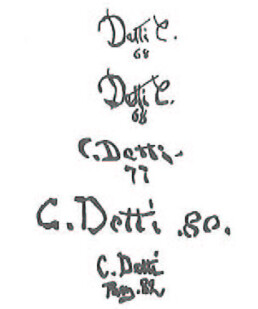
Detti Cesare Augusto *
DETTI CESARE AUGUSTO
Spoleto (Perugia) 1847 – Parigi 1914
Giovanissimo, fu allievo a Roma di F. Podesti, di F. Coghetti e di M. Fortuny. Passò presto dalla produzione di piccoli acquerelli di costume alla pittura a olio, prediligendo soggetti di genere che, grazie a una smagliante tavolozza, furono giudicati «irresistibili» da amatori e collezionisti. Trasferitosi a Parigi negli anni ’70, iniziò a esporre al Salon fin dal 1879, con ampi consensi, pur continuando a inviare opere anche alle più importanti rassegne italiane (nel 1877, a Napoli, L’addio alla patria e nel 1880, a Torino, Bottino di guerra e Perduti tra la nebbia). L’attenzione del mercante A. Goupil contribuì al suo successo e allargò la notorietà del pittore anche al mercato inglese e americano. Fu presente alle mostre di Parigi (1889, Temps heureux, L’Aurore, Trois bons amis, Un mariage; 1890, Le tricheur), a Milano (1906, Ballo dell’Opéra-Paris, Raggio di sole, Preghiere della sera); la sua ricchissima produzione fu improntata a quel gusto pasticheur con cui l’artista combinò virtuosismi neofiamminghi (Il Duca di Guisa, teatro Nuovo, Spoleto) e leziose citazioni da esempi inglesi e francesi del Settecento (La passeggiata in villa, Le signorine Detti e il Ritratto di signora col cagnolino, tutti alla Pinacoteca Comunale di Spoleto), guardando anche a J. L. E. Meissonier e in parte a Fortuny.
